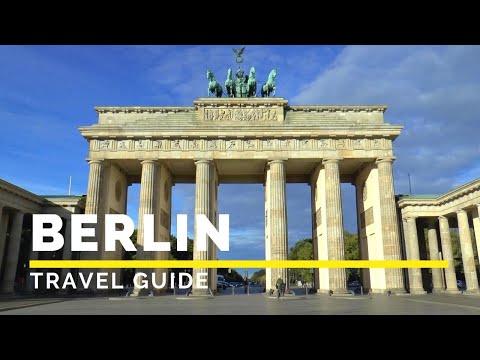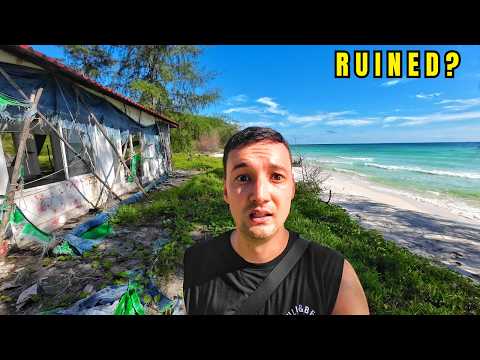BERLIN GERMANY Ultimate Travel Guide | Top Things To Do In Berlin (2021) | Happy Trip

Berlin, Germany's capital, is absolutely one of the world's most beautiful and interesting places to visit; with its turbulent and rich history, as well as its stunning architecture. The diversity of cultural and historical attractions makes this vibrant city an extremely popular tourist destination. If you’re planning a trip to this exciting city, look no further because this is the ultimate travel guide to Berlin! Brandenburger Tor, or the Brandenburg Gate, is Berlin’s only surviving historical city gate and is one of Germany's most iconic landmarks. It has been the site of many significant historical events. It symbolized East and West division in the past; but today, it is considered a symbol of unity and peace.
This neo-classical structure managed to survive despite being heavily damaged after World War II. Colorful and diverse events, which bring thousands of people to the streets, are also held here. Siegessäule, or the Victory Column, is situated on a roundabout island called the “Big Star”. The monument shows the gold-plated statue of Victoria, the goddess of victory, affectionately called "Gold Else" by the locals.
The column can be reached over several pedestrian tunnels. There are 285 steps to climb up to the viewing platform located below Victoria's figure, with the spiral staircase narrowing as it approaches the top. There, you will be rewarded with a terrific view of the city. As New York has Central Park and London has Hyde Park, Berliners have the Tiergarten Park. The forested grounds and open green lawns cover 210 hectares. They are ideal for picnics, leisurely strolls, playtime with the children and pets, jogging or just sitting on a bench relaxing and enjoying the trees, the views and the sun.
The park is close to the city center and borders sights such as the Brandenburg Gate, Potsdamer Platz, Victory Column, Bellevue Palace and the Soviet War Memorial. Schloss Bellevue, or the Bellevue Palace, has been the official residence of the President of Germany since 1994. The palace is used mainly for receptions and state visits. There is an open house once a year when the general public is invited to visit. Every year, thousands of visitors come to the Reichstag, the current home of Germany's parliament.
The building was severely damaged after World War II. Full restoration started in the 1990s after the German reunification and was completed in 1999. The dome has become the supreme symbol of German unity and democracy.
The viewing platform gives an impressive 360-degree view over Berlin. The dome and roof terrace are open to visitors for free, but advance registration is required. Hauptbahnhof, or the Berlin Central Station, Bundeskanzleramt, or the Federal Chancellery, is an elegant building situated near the Reichstag parliament building.
Here, you will find the offices of the German Chancellor and the chancellery staff. Its modern architecture comprises a nine-story main building and two administrative wings. The chancellery is the largest government headquarters globally. is one of Berlin's most impressive architectural structures and is the main hub for all rail traffic. It is considered to be the largest station in all of Europe, connecting regional and inter-city trains with Berlin's local public transportation system. Long-distance rail lines connect Berlin with all major German cities and many cities in neighboring European countries.
The Memorial to the Murdered Jews of Europe, also known as the Holocaust Memorial, serves as a place of remembrance for the Jewish victims of the Holocaust. Its open, abstract design consists of 2711 concrete slabs. The information center holds the names of approximately 3 million Jewish Holocaust victims. Potsdamer Platz is a vibrant public square in the center of Berlin.
After decades of neglect, this place has been transformed into a hub of bustling activity amidst shopping centers, theatres and gorgeous modern architecture. The Sony Center is an impressive entertainment center where you will find cinemas, restaurants, a film museum and the Legoland Discovery Centre. Finally, if you happen to look down, you will also see a metal strip laid in the ground marking the route of the Berlin Wall. Checkpoint Charlie became a well-known border crossing point between East and West Germany during the Cold War.
From 1961 to 1990, this site was used as the main entry and departure point for visitors who were allowed to enter East Berlin. A reconstruction of the US Army guardhouse can be seen on the site today. The name “Checkpoint Charlie” comes from the letter “C” on the NATO phonetic alphabet, with “Charlie” being the third checkpoint built by the Allies. Cobblestones show the spot where the former border stood, and the photographs of an American and Soviet soldier can also be seen here. You can visit the nearby museum, which documents the many escape attempts from East to West, and also exhibits the original checkpoint sign.
The Topography of Terror is one of the most popular history museums and memorial sites in the city. The exhibition shows photographs, graphics, and documents depicting the crimes of persecution and terror organized there, and shows the history of the Nazi regime from the time they came into power until the end of the war. Near Checkpoint Charlie and Topography of Terror, you can get a lift in one of the world’s largest captive balloons or take a ride in a Trabant to learn more about these East German cars. Gendarmenmarkt is a public square in Berlin, bordered by the French Cathedral and the German Cathedral on each side.
The Concert Hall, home to the Berlin Symphony Orchestra, stands between the two churches. In the summer, this beautiful square becomes an open-air stage where orchestras play concerts. During the Christmas season, it transforms into a festive market, with decorated wooden booths selling local handicrafts and Christmas specialties. A UNESCO World Heritage Site, Museum Island holds five large museums built from 1830 to 1930; as well as a reception building and art gallery called the James Simon Gallery.
Also located on Museum Island is the Berlin Cathedral, which is the largest church in Berlin and the largest Protestant church in Germany. It is one of the prominent landmarks in the city. The intricate ornamental designs and remarkable statues are an absolute must-see.
There is also a museum that exhibits designs and models highlighting the Cathedral's history. We recommend to walk up to the dome's outer walkway to get amazing panoramic views of Berlin. The Old Museum, or the Altes Museum, was the first museum to be built on the island. This building houses Greek, Etruscan and Roman art and sculptures.
There is a vast collection of gold and silver jewelry, vases, and a special treasure chamber filled with a spectacular array of historical coins. The New Museum, or the Neues Museum, was initially designed as an extension to the Old Museum. Some of its highlights include the bust of Nefertiti, the famous queen of Egypt; as well as the 700,000 year-old axe head from the Stone Age. The third museum to be built in 1876 was the Old National Gallery, or the Alte Nationalgalerie.
This is Berlin's biggest art gallery, with paintings and sculptures from the 19th century. The Bode Museum houses a unique collection of sculptures and works from different eras, as well as a gallery that contains half a million coins and medals. The Pergamon Museum was the last of the five large museum buildings to be built; and exhibits the Antiquity Collection, the Islamic Art Museum and the Middle East Museum. TV Tower is one the tallest structures in Europe, with a height of 368 meters. It is the most visible landmark in the city and has become a worldwide symbol of Berlin.
This magnificent structure welcomes over a million tourists every year. An express elevator transports visitors within 40 seconds to the observation platform, where they will be greeted with stunning panoramic views of the entire city. Alexanderplatz is the biggest public square in Germany and one of the most visited areas in Berlin.
Aside from being a popular film location, it is an important junction for public transportation such as trains, subways, trams and buses. Here, you will also find numerous shopping malls, department stores and other commercial establishments. The East Side Gallery, known as the world’s longest open-air gallery, welcomes over 3 million visitors every year. The artworks were painted directly on the 1.3-kilometer remaining stretch of the Berlin Wall by over a hundred artists from 21 countries. It opened in September of 1990 and was subsequently designated as a protected landmark.
Some of the more popular murals here are the “Fraternal Kiss” by Dmitri Vrubel and “Test the Rest” by Birgit Kinder. The Kaiser Wilhelm Gedächtniskirche, or the Kaiser Wilhelm Memorial Church, is the most famous landmark on the city's western side. It is one of Berlin's most important churches, serving as a stark reminder on the devastating effects of war.
You will find the ruins of the church destroyed from a bombing raid during World War II, as well as a modern church building beside it. Guided tours of the church and tower ruins are free of charge, but donations are welcome. It is recommended to donate at least 5 euros per person.
Tours are generally held in German, but can also be done in English upon request. Individual tours can also be booked. We recommend visiting the popular Christmas market that usually takes place between late November until the end of December. First opening its doors in 1907, the 60,000-square meter Kaufhaus des Westens, abbreviated as KaDeWe, is one of the largest department stores in Europe.
It offers an impressive mixture of luxury and high-end goods. Be sure to visit the famous Delicatessen on the 6th floor, where you will find a wide variety of food and beverage. Schloss Charlottenburg, or Charlottenburg Palace, is Berlin's largest historical palace. It was named after Sophie Charlotte, the first Queen consort in Prussia. The figure of the goddess Fortuna stands on top of the palace dome.
Inside, you can visit rooms filled with beautiful collections of antique porcelain, as well as displays of elegant tableware made of gold, silver, glass and porcelain. The palace also displays the Prussian Crown Jewels and is home to an archaeology museum. Visitors can enjoy a stroll outside the beautiful gardens surrounding the Palace. If you would like to experience Berlin in a unique way, we recommend exploring one or more of the city's farmer's markets. There, you can enjoy a wonderful array of harvested fruits and vegetables, and fresh flowers.
You can also find a wide variety of food from meats and fish to bread, jams, cheese and cakes; as well as local handicrafts, clothing and household goods. The Spree is the main river of Berlin and flows through its city center. You can find boat tours that will take you along most of the city's historic sights and popular places.
It offers both tourists and locals a relaxing way to see the city from another perspective. You see that? And then you can see the whole wide world!
2021-01-17 09:52


